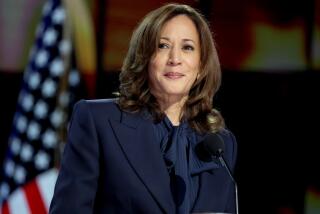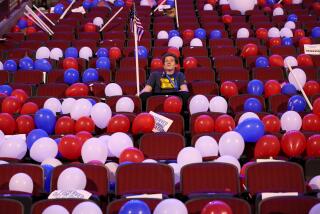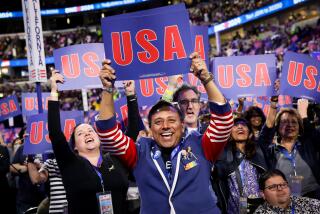NEWS ANALYSIS : GOP Seeking to Rekindle Spark of Old Victories
HOUSTON — As George Bush might put it: “Message: A big job. Too big for that other guy. Liberal in disguise. Cheeky wife. But you know me. Comfortable. Strong resolve. Experience. Trust. Traditional values.”
That, in the fractured phrasing of the President and the jump-cut pacing of television, is the impression the Republican Party hopes to deliver to Americans over television, newspapers and radio during the party’s national convention here.
The point will be to remind people of old things that they liked about the GOP, about the country and about Bush.
Under the general theme of “A Tribute to the American Spirit,” the party has tried to arrange for the television cameras as many elements as possible to put across that message, from classic red, white and blue colors to indoor fireworks.
Yet there is evidence that this year the Republicans are less tightly organized and, in some cases, less expert than in the past. Uncharacteristically, the camera sight lines are not great for television. And much like the Democrats, Bush campaign officials are not sure they will be able to review all the speeches beforehand to ensure they all strike the right themes.
The main message was recently spelled out by James Lake, the campaign’s communications adviser.
“From the time of his acceptance speech (at the 1988 convention) through the first three years, I think we have learned a lot about George Bush’s resolve, his steadiness, his leadership,” Lake said.
“But over the course of the last year this man has failed to convey his policies as well as we would like. We want to remind (convention viewers) of the tremendous character and resolve and integrity that this man possesses and persuade people that this is a man that they can feel comfortable with.”
To accomplish that, the Republicans have picked a different theme for each of the convention’s first three nights. Tonight’s proceedings--featuring Ronald Reagan--will stress foreign policy accomplishments, as well as remind people of the party’s traditions.
Tuesday’s emphasis is on domestic policy and will feature various governors and cabinet members. Two future presidential prospects are among those delivering speeches: Housing and Urban Development Secretary Jack Kemp and Texas Senator Phil Gramm.
Wednesday is family values night. First Lady Barbara Bush addresses the convention, and the Bush and Dan Quayle families will be spotlighted on a specially designed podium with glass sides so that the small children will be visible to the cameras.
Thursday night’s focus will be squarely on the GOP ticket, as Vice President Quayle and Bush deliver their acceptance speeches.
Contrary to those who argue these affairs are no longer important, Republican officials believe political conventions have become the key events in the general election campaign--save for the nationally televised debates in the fall--because many Americans who normally don’t pay attention to politics will be watching.
Even though TV ratings for the conventions have been declining since 1976, more than 30 million Americans watched Democrat Bill Clinton’s acceptance speech, and millions more watched portions on the news, heard a snippet on radio or caught something about it on the morning shows. Conventions, rather than merely the events that take place in the hall, are weeklong splashes of concentrated media, in effect taking place through the airwaves.
This week, Republican leaders “are going to appeal to their core constituency, and if they can do that they have made progress,” said Michael K. Deaver, Reagan’s former media adviser.
But doing this through the media has never come naturally to the Bush Administration, Deaver said. “Television is an impression. Television is feelings. That is part of what the Bush Administration doesn’t appear to understand.”
In seeking to control the “feeling” this year, the party has struggled with several potential conflicts.
What will Patrick J. Buchanan say? Last week, campaign convention coordinator Craig Fuller said he would be reading in advance the remarks of all those speaking under the faux sandstone arches behind the podium. Buchanan promptly rebuffed him.
It now seems clear that Buchanan will lead the attack on the Democrats tonight, turning his remarkable ability for the cutting phrase against Bill Clinton, whom the Republicans intend to depict as untrustworthy.
What kind of family values will the Republicans represent? That depends on when you tune in--to the early show on CNN or C-SPAN, or to prime-time network broadcasts.
On Wednesday, television evangelist Pat Robertson will speak, a late addition to satisfy conservatives. But Robertson will not be speaking when the networks switch to the scene in Houston about 6 p.m. PDT. The evening time slots will be reserved for Marilyn Quayle, Barbara Bush and Labor Secretary Lynn Martin. The First Lady would prefer abortion be left out of the party platform and Martin is an abortion rights advocate.
The party similarly will try to dispatch any differences over platform questions this afternoon, before the first network coverage. And while conservatives dominated the platform hearings and will enjoy a good deal of prime-time coverage, they are mostly shunted to Monday and Tuesday nights. By Wednesday and Thursday, the impression left will likely be more moderate.
These conflicts have made the Republican message more complicated. “I have yet to see that they have a clear story line,” said William Wheatley, the executive producer of political coverage for NBC.
In some things, the usually well organized Republicans seem as masterful as ever. “They are detail freaks,” said ABC executive producer Jeff Gralnick. “They’re like NASA.”
Although the minute-by-minute schedule that the Republicans are famous for was not ready as early as in past years, or as early this time as the one for the Democratic convention, it is scripted to a fine point. The demonstration and ending applause tonight for Reagan, for instance, is to begin at 7:57 p.m. and end at 8:07.
The set design is “American classic,” according to its designer, Hollywood television veteran Robert Keene. It is dominated by red, white and blue colors and a massive archway behind the podium that suggests the authority of the incumbent party.
In the struggle to get as much television exposure as possible, network officials say the party has stacked many of the big speeches late in the evening so that the networks will have to run over the 11 p.m. eastern time zone time slot to carry them.
This will guarantee that these events will be seen in prime time in western states key to the Republican electoral strategy and that the networks will stay on the air longer.
The Republicans also will have two giant video walls, compared with the Democrats’ one.
And while Clinton’s acceptance speech sparked some criticism for lasting almost an hour, the Republicans plan to be more terse in their comments. Reagan is to speak for 30 minutes, Buchanan 20, Quayle 15 and Bush 30--all lengths that are workable around commercials. At least, that is the plan.
But there remain the signs of uncharacteristic chaos.
One key television professional brought in to help organize the convention was shocked that the Bush campaign seemed fuzzy about what it wanted. Rather than provide guidelines about what image they wanted to capture, campaign and party officials simply told him to look at tapes of the 1980, ’84 and ’88 conventions and make whatever adjustments he thought was necessary. He was equally surprised when they accepted 100% of his ideas.
“They never said you need to do this or that or this is what we are trying to convey,” the official said.
Other network officials working closely with the party said there seemed to be multiple layers of bureaucracy involved this year, some of them added in recent weeks, which had made for a cumbersome production process.
“After being extremely well organized, things seemed to get a little confused in the last month after the Democratic convention,” said one network executive producer. “They seemed to panic a little.”
A sign of the less-than-expert planning is that one of the places where television cameras were supposed to be hidden on the stage was poorly designed, so the cameras had to be put out in full view. That, in turn, partially obscures the angles for shots of a given speaker with the sea of delegate faces in front.
More to Read
Get the L.A. Times Politics newsletter
Deeply reported insights into legislation, politics and policy from Sacramento, Washington and beyond. In your inbox three times per week.
You may occasionally receive promotional content from the Los Angeles Times.










